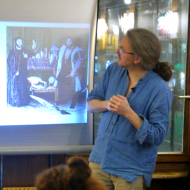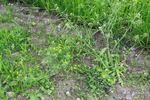
BILLIARD Sylvain
- Evo-Eco-Paléo UMR CNRS 8198, Université Lille, Villeneuve-d'Ascq, France
- Evolutionary Dynamics, Evolutionary Ecology, Evolutionary Theory, Population Genetics / Genomics, Reproduction and Sex, Species interactions
- recommender
Recommendation: 1
Reviews: 0
Recommendation: 1

Variation in competitive ability with mating system, ploidy and range expansion in four Capsella species
When ecology meets genetics: Towards an integrated understanding of mating system transitions and diversity
Recommended by Sylvain Billiard and Henrique Teotonio based on reviews by Yaniv Brandvain, Henrique Teotonio and 1 anonymous reviewerIn the 19th century, C. Darwin and F. Delpino engaged in a debate about the success of species with different reproduction modes, with the later favouring the idea that monoecious plants capable of autonomous selfing could spread more easily than dioecious plants (or self-incompatible hermaphroditic plants) if cross-pollination opportunities were limited [1]. Since then, debate has never faded about how natural selection is responsible for transitions to selfing and can explain the diversity and distribution of reproduction modes we observe in the natural world [2, 3].
Explanations for mating systems diversity, and transitions to selfing in particular, generally fall into two categories: either genetic or ecological. On the genetic side, many theoretical works showed a critical role for mutation load and inbreeding depression, transmission advantage and reproductive assurance in the evolution of selfing, e.g. [4]. Many experimental works were conducted to test theoretical hypotheses and predictions, especially regarding the magnitude of inbreeding depression; see [5] for a review. Ecologically, the presence of selfing populations is usually correlated with fragmented and harsh habitats, on the periphery of ancestral outcrossing populations. The cause of this distribution could be that selfers are better dispersers and colonizers than outcrossers, or variations in other life-history traits [6]. Yet, few experiments were run to assess whether selfing species or populations have effectively different ecological characteristics, and even scarcer are experiments evaluating both the roles of mutational load and life-history traits evolution. This is the aim of the present study by X. Yang et al [7].
The study of Yang et al [7], together with that of Petrone Mendoza et al. [8], supervised by S. Glémin and M. Lascoux, is probably one of the first to conduct experiments where the competitive abilities are compared between and within species. Using 4 species of the Capsella genus, annual plants from the mustard family, they tested the theoretical predictions that i) the transition from outcrossing to selfing resulted in reduced competitive ability at higher densities, because of the accumulation of deleterious mutations and/or the evolution of life-history traits in an open habitat and a colonization/dispersal trade-off; ii) that reduced competitive ability of selfers should be less pronounced in polyploid then diploid species because the effect of partially recessive deleterious mutations would be buffered; and iii) that competitive ability of selfers should decline with historical range expansion because of the expansion load [9].
Of the 4 Capsella species studied, only one of them, presumably the ancestral, is a diploid outcrosser with a small distribution but large population sizes. The three other species are selfers, two diploids with independent histories of transitions from outcrossing, and another, tetraploid, resulting from a recent hybridization between one of the diploid selfer and the diploid outcrossing ancestor. Many accessions from each species were sampled and individuals assayed for their competitive ability against a tester species or alone, for vegetative and reproductive traits. The measured vegetative traits (rosette surface at two stages, growth rate and flowering probability) showed no differentiation between selfers and outcrossers. To the contrary, reproductive traits (number of flowers) followed theoretical predictions: selfing species are more sensitive to competition than the outcrossing species, with polyploid selfing species being intermediate between the diploid selfers and the diploid outcrosser, and within the tetraploid selfing species (where sampling was quite significant across a large geographical range) sensitivity to competition increased with range expansion.
The study of Yang et al. [7] suffers from several limitations, such that alternative explanations cannot be discarded in the absence of further experimental data. They nonetheless provide the reader with a nice discussion and prospects on how to untwine the causes and the consequences of transitions to selfing. Their study also brings up to date questions about the joint evolution of mating system and life-history traits, which needs a renewed interest from an empirical and theoretical point of view. The results of Yang et al. raise for instance the question of whether it is indeed expected that only reproductive traits, and not vegetative traits, should evolve with the transition to selfing.
The recommandation and evaluation of this paper have been made in collaboration with Thomas Lesaffre.
References
[1] Darwin, C. R. (1876). The effects of cross and self fertilization in the vegetable kingdom. London: Murray.
[2] Stebbins, G. L. (1957). Self fertilization and population variability in the higher plants. The American Naturalist, 91, 337-354. doi: 10.1086/281999
[3] Harder, L.D. & Barrett, S. C. H. (2006). Ecology and evolution of flowers. Oxford: Oxford University Press.
[4] Porcher, E. & Lande, R. (2005). The evolution of self-fertilization and inbreeding depression under pollen discounting and pollen limitation. Journal of Evolutionary Biology, 18(3), 497-508. doi: 10.1111/j.1420-9101.2005.00905.x
[5] Winn, A.A., et al. (2011). Analysis of inbreeding depression in mixed-mating plants provides evidence for selective interference and stable mixed mating. Evolution, 65(12), 3339-3359. doi: 10.1111/j.1558-5646.2011.01462.x
[6] Munoz, F., Violle, C. & Cheptou, P.-O. (2016). CSR ecological strategies and plant mating systems: outcrossing increases with competitiveness but stress-tolerance is related to mixed mating. Oikos, 125(9), 1296-1303. doi: 10.1111/oik.02328
[7] Yang, X., Lascoux, M. & Glémin, S (2018). Variation in competitive ability with mating system, ploidy and range expansion in four Capsella species. bioRxiv, 214866, ver. 5 recommended and peer-reviewed by PCI Evol Biol. doi: 10.1101/214866
[8] Petrone Mendoza, S., Lascoux, M. & Glémin, S. (2018). Competitive ability of Capsella species with different mating systems and ploidy levels. Annals of Botany 121(6), 1257-1264. doi: 10.1093/aob/mcy014
[9] Peischl, S. & Excoffier, L. (2015). Expansion load: recessive mutations and the role of standing genetic variation. Molecular Ecology, 24(9): 2084-2094. doi: 10.1111/mec.13154